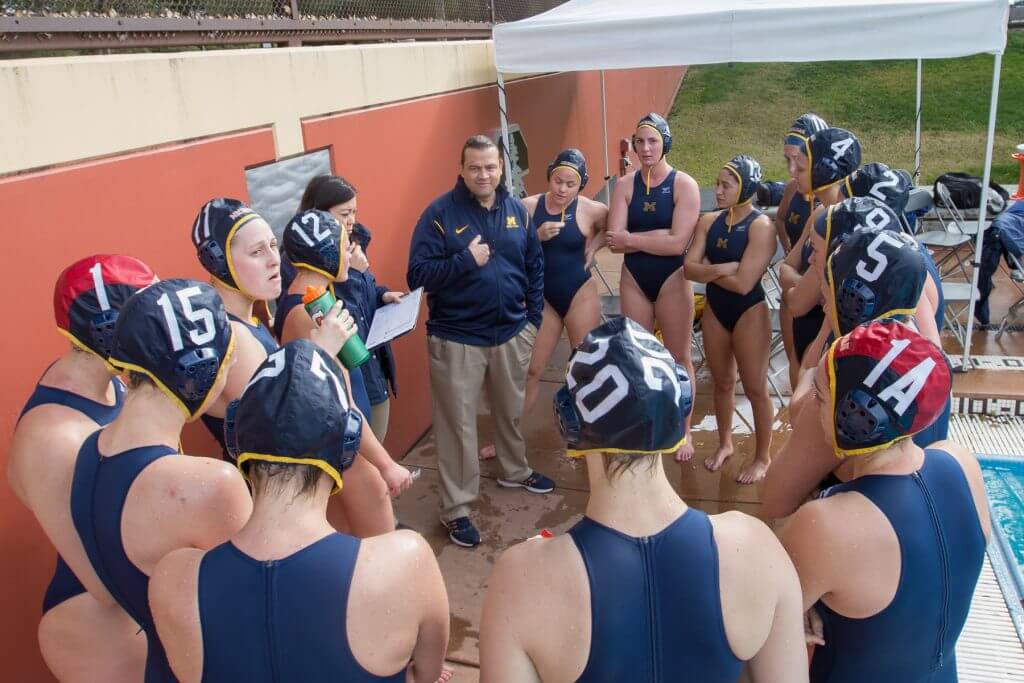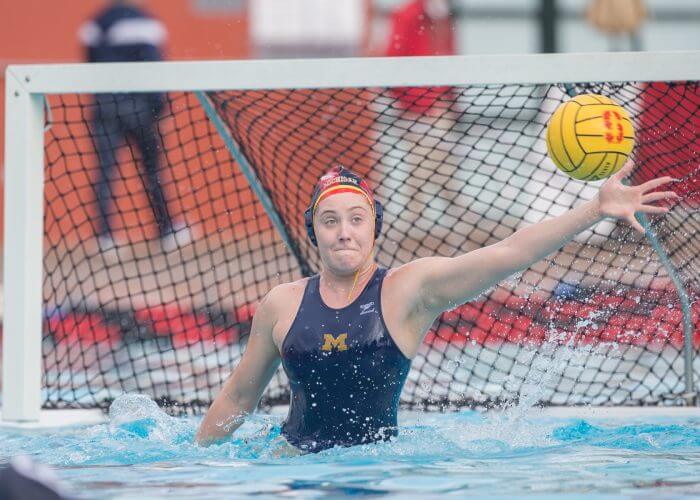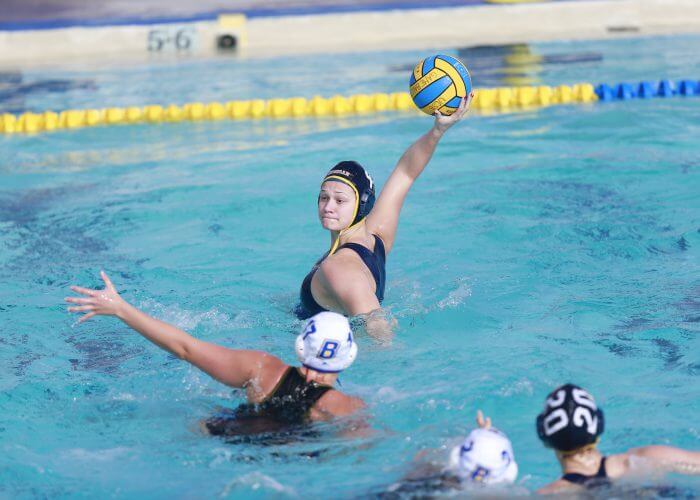Water Polo Profile: Marcelo Leonardi of Michigan, USA Water Polo

By Michael Randazzo, Swimming World Contributor.
Since arriving at the University of Michigan in 2014, Michigan head coach Marcelo Leonardi has directed one of the country’s top women’s water polo programs to even greater heights. Last year the Wolverines went 30-8, beat U Cal Berkeley for the first time and — following a fourth-place finish in the 2016 NCAA Women’s Water Polo Tournament — achieved the program’s highest-ever ranking (#4).
I caught up with the Wolverines’ coach at the 2017 Stanford Invitational, where Michigan beat #8 Hawaii to claim third place after dropping a 13-9 decision to #4 Cal. Leonardi spoke about his current squad, his connection to Cal coach Coralie Simmons through the U.S. Women’s Youth National Team, the impact of returning Olympians on NCAA competition and the rise of women’s water polo in Ann Arbor.
After a tough loss to Cal on Saturday your team stepped up with wins Sunday over San Jose State and Hawaii.
[Senior] Allison Skaggs had a fantastic game against Hawaii. She established herself at 2-meters and scored some clutch goals. And we had Heidi Ritner, who is probably the best goalie in her age group as a freshman, coming in and starting. It took her a couple of games to get going this weekend, but she played her best game [against the Waves].
At the end of the day our defense ended up winning but Heidi made critical saves on Hawaii’s last two 5-on-6 possessions that sealed the deal.
You’ve got three other goalies on your roster, including senior Emily Browning, but you’re playing a freshman.
Having a freshman starting [is unusual] but it’s her ability and [the] international experience she brings from playing in our national team pipeline — though young, she’s a seasoned veteran. Heidi makes freshman mistakes but she shines in the big moments.

Heidi Ritner of Michigan. Photo Courtesy: Maciek Gudrymowicz
The Wolverines will spend much of January, February and March in California playing a difficult schedule.
When I first took the job I sat down to make the best schedule in the country. To do that we have to come out to California and play top-5, top-10 teams.
For us to make NCAAs we either have to be conference champions or we have to gain the at-large bid, which has a direct correlation to our RPI. If we’re tested every other week, it keeps us sharp.
By the time we get to conference play [in the Collegiate Water Polo Association] we are well prepared for it.
You and Coralie Simmons, Cal’s new coach, know each other from the U.S. Women’s National Youth Team.
Coralie and I have been on staff together with the US National Team the past four years. We won gold in Madrid in 2014 and we just finished off the second cycle of youth world championships in New Zealand [in December].
We know each others’ tendencies [and] spend a lot of time just getting better. [Besides] the rich conversations that we have, from technical to tactical to motivation, we share things that are happening in our families.
For her to take over the Cal program is not only fantastic for her but for Cal. Anytime there’s a chance to face each other, we joke about it. We had our first round going against each other this weekend and it was good game. Cal’s very talented and she’s doing a great job changing the culture of that program.
Now that the Rio Olympics are over, Olympians are flocking to U.S, colleges. What impact will that have on American polo?
Having all the Olympians back has elevated the level of water polo throughout the country. And I’m not just talking domestically. You also have a lot of international players who — even though they didn’t make the top eight at the Olympics — still went through qualifiers to make the Games.
The level of play has definitely gone up, which in turn has forced other teams to elevate their game. If you take a look at the ages of all the Olympians, they’re very young. I’ve been coaching at the collegiate level since 2004; this is the best intercollegiate water polo has been since I started.
You are an important part of the pipeline for American players progressing to the national team.
I feel the youth national team is the most significant part of the pipeline. At the youth level is where you determine whether an athlete is going to be a future Olympian or not. From there, it’s not just going to the junior team; they will automatically train with the senior team and every other cycle they’ll go to junior worlds or youth worlds.
I’ll give you an example: back in Madrid in 2014 at the Youth World Championships, Maddie Musselman and McKenzie Fischer, who were both high school players at the time, helped us win the gold. In 2016, both were Olympians walking away with gold medals [from Rio]. There’s a direct correlation between development at the youth level and preparing future Olympians.
The U.S. won gold in almost every single major tournament since 2011. But you also see the rest of the world closing the gap. There’s talent everywhere from Australia to Spain to Greece – and that’s good for water polo.
As a Californian your familiar with the great tradition of Stanford polo. What’s special about playing in their Invitational?
It’s always a great honor to play at the Stanford Invite.
At halftime of our Hawaii game I turned to my team and said: “This is where you want to be.”
You want to be playing not only the best teams but in the best venues as well. What’s also nice about it is it gives a chance to our athletes — probably 95% are either from Southern or Northern California — to come back to California and see their families.
There’s a robust polo scene Ann Arbor; how is it to be in one of the country’s hotbeds for the sport outside of California?
When I had the opportunity to go to Michigan, one of the things [the drew me] was developing the area whether through ODP, club or high school [polo]. There’s a rich level of water polo in the Midwest that’s starting to bloom.
If you look at my roster we have a Michigander in Kimberly Graziano from Skyline High School. And if you look at Ann Arbor history from Betsey Armstrong to Alison Gregorka to Katie Dudley to Graziano you’ve had elite DI athletes come out of the Michigan area.

Kimberly Graziano of Michigan. Photo Courtesy: Maciek Gudrymowicz



